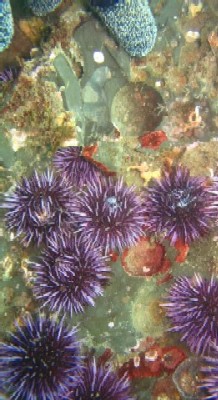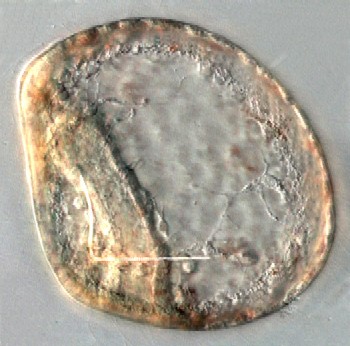Navigation
Decoded Sea Urchin Genome Shows Surprising Relationship to Humans
"Unraveling the sea urchin genome has yielded striking similarities and surprising differences between sea urchins and humans," said Judith Venuti, program director in NSF's Integrative Organismal Biology Division.
 |
| A group of adult purple sea urchins spawns in a kelp bed off the California coast. Photo credit: Charles Hollahan, Santa Barbara Marine Biologicals at: admin@sbmarinebio.com |
The Sea Urchin Genome Sequencing Project (SUGSP) Consortium, led by the Human Genome Sequencing Center at Baylor College of Medicine (BCM-HGSC) in Houston, announced on November 9, 2006 the decoding and analysis of the genome sequence of the sea urchin, Strongylocentrotus purpuratus.
The results are presented in the Nov. 10 issue of the journal Science, and 41 companion manuscripts describing further detailed analyses are contained in that journal and in a special issue of the journal Developmental Biology, appearing on Dec.1, 2006.
The genome of a male California purple sea urchin was sequenced, which contained more than 814 million DNA "letters," spelling out 23,300 genes. Nearly 10,000 of the genes were scrutinized by an international consortium of 240 scientists from more than 70 institutions in 11 countries. The sequence covers more than 90 percent of the genome.
The BCM-HGSC generated the sequence data for the SUGSP, then assembled the genome and led the analysis consortium. Additional resources for the project included a BAC library (clones with very large pieces of DNA) prepared at the California Institute of Technology and a physical map prepared at the Michael Smith Genome Sciences Centre at the British Columbia Cancer Agency in Vancouver.
The project was led by Erica Sodergren and George Weinstock, a team at the BCM-HGSC, along with Richard Gibbs, director of the BCM-HGSC, and Eric Davidson and Andrew Cameron of the California Institute of Technology. The National Human Genome Research Institute of the National Institutes of Health provided funding for the SUGSP, with the National Science Foundation (NSF) also a supporter.
"Unraveling the sea urchin genome has yielded striking similarities and surprising differences between sea urchins and humans," said Judith Venuti, program director in NSF's Integrative Organismal Biology Division.
"Expansion of sequencing beyond medically-relevant organisms is providing scientists with a treasure trove of new insights and information," added Judith Plesset, also a program director in NSFs Integrative Organismal Biology Division.
Sea urchins are echinoderms (Greek for spiny skin), marine animals that originated over 540 million years ago and include starfish, brittle stars, sea lilies, and sea cucumbers. Following the great extinction of animals 250 million years ago, the modern sea urchins emerged as dominant echinoderm species. The purple sea urchin emerged in the North Pacific Ocean during a rapid burst of speciation and diversification 15-20 million years ago.
There was great interest in the sea urchin as a target for genome sequencing because these animals share a common ancestor with humans, scientists said. That ancestor lived over 540 million years ago and gave rise to the Deuterostomes, the super phylum of animals that includes phyla such as echinoderms and chordates, the phylum to which humans and other vertebrates belong.
All Deuterostomes are more closely related to each other than they are to any other animals not included in the Deuterostome super phylum. For example, among sequenced genomes, the genomes of fruit flies and worms are more distant from the sea urchin genome than is the human genome.
"This analysis shows that sea urchins share substantially more genes and biological pathways with humans than previously suspected," said Francis Collins, director of the National Human Genome Research Institute at the National Institutes of Health, which supported the research.
"Comparing the genome of the sea urchin with that of the human and other model organisms will provide scientists with novel insights into the structure and function of our own genome."
To discover how sea urchins and humans can be so different, yet be related by descent from an ancient relative, their genomes were compared. The sea urchin is an invertebrate and the first example of a Deuterostome genome outside the chordates.
 |
| An sea urchin embryo in a gastrula stage. Photo: A. Ransick, California Institute of Technology |
The sea urchin fills a large evolutionary gap in sequenced genomes," said Weinstock. "It allows us to see what went on in evolution after the split between the ancestors that gave rise to humans and insects. The sea urchin genome provided plenty of unexpected rewards and was a great choice for sequencing."
Comparing the genes of the sea urchin to the human gene list shows which human genes are likely to be recent innovations in human evolution and which are ancient. It also shows which human genes have changed slowly in the lineage from the ancestral Deuterostome animal and which are evolving rapidly in response to natural selection.
This information, scientists say, will make it possible one day to know the history of every human gene - and build a picture of what the extinct ancestors that gave rise to animal life from worms to humans looked like.
"More than 30 years ago Roy Britten and Eric Davidson offered a comprehensive theory of gene regulation in higher organisms and the sea urchin has been the premier model for testing these predictions" said Richard Gibbs, Director of the BCM-HGSC. "The complete sequence is now available to further these studies."
Because of its evolutionary position, the sea urchin genome sequence was unknown biological territory, said scientists affiliated with the SUGSP.
Some of their discoveries are:
- The sea urchin had most of the same gene families found in humans, the Deuterostome toolkit used to create animals in this super phylum. However the size of gene families was often larger in humans, reflecting in part two whole genome duplication events during vertebrate evolution, after the separation of the sea urchin and human evolutionary lines.
- One unexpected exception to this size rule was the immune system. Humans have innate and acquired immunity systems. The sea urchin has some of the genes of the acquired immunity system, but its innate immunity branch is greatly expanded with 10 to 20 times as many genes as in humans. Innate immunity is the set of proteins that are "hard-wired" to detect unique molecules of bacteria, such as their cell walls, and signal alert the body to the intruders.
- The sea urchin has genes for sensory proteins that are involved in vision and hearing in man. Yet the sea urchin has no eyes or ears, at least as we know them. Some of the visual sensory proteins are located to an appendage known as the tube foot, and likely function in sensory processes there. It is remarkable that the same sensory proteins are used in organs with such different structures in sea urchins and man, said Sodergren.
"The sea urchin reminds us of the underlying unity of all life on earth," she said. "It is a similar set of genes and proteins being reused in different ways, different numbers, and at different times in the life cycle to create the diversity of living forms."
Many of the sea urchin biologists who participated in the Sea Urchin Genome Project are supported by NSF.
This is from a National Science Foundation Press Release Press Release 06-162.
Related Websites
Sea Urchin Genome Project
Search
Latest articles
Agriculture
- World Water Week: Healthy ecosystems essential to human health: from coronavirus to malnutrition Online session Wednesday 24 August 17:00-18:20
- World Water Week: Healthy ecosystems essential to human health: from coronavirus to malnutrition Online session Wednesday 24 August 17:00-18:20
Air Pollution
- "Water and Sanitation-Related Diseases and the Changing Environment: Challenges, Interventions, and Preventive Measures" Volume 2 Is Now Available
- Global Innovation Exchange Co-Created by Horizon International, USAID, Bill and Melinda Gates Foundation and Others
Biodiversity
- It is time for international mobilization against climate change
- World Water Week: Healthy ecosystems essential to human health: from coronavirus to malnutrition Online session Wednesday 24 August 17:00-18:20
Desertification
- World Water Week: Healthy ecosystems essential to human health: from coronavirus to malnutrition Online session Wednesday 24 August 17:00-18:20
- UN Food Systems Summit Receives Over 1,200 Ideas to Help Meet Sustainable Development Goals
Endangered Species
- Mangrove Action Project Collaborates to Restore and Preserve Mangrove Ecosystems
- Coral Research in Palau offers a “Glimmer of Hope”
Energy
- Global Innovation Exchange Co-Created by Horizon International, USAID, Bill and Melinda Gates Foundation and Others
- Wildlife Preservation in Southeast Nova Scotia
Exhibits
- Global Innovation Exchange Co-Created by Horizon International, USAID, Bill and Melinda Gates Foundation and Others
- Coral Reefs
Forests
- NASA Satellites Reveal Major Shifts in Global Freshwater Updated June 2020
- Global Innovation Exchange Co-Created by Horizon International, USAID, Bill and Melinda Gates Foundation and Others
Global Climate Change
- It is time for international mobilization against climate change
- It is time for international mobilization against climate change
Global Health
- World Water Week: Healthy ecosystems essential to human health: from coronavirus to malnutrition Online session Wednesday 24 August 17:00-18:20
- More than 400 schoolgirls, family and teachers rescued from Afghanistan by small coalition
Industry
- "Water and Sanitation-Related Diseases and the Changing Environment: Challenges, Interventions, and Preventive Measures" Volume 2 Is Now Available
- Global Innovation Exchange Co-Created by Horizon International, USAID, Bill and Melinda Gates Foundation and Others
Natural Disaster Relief
- STOP ATTACKS ON HEALTH CARE IN UKRAINE
- Global Innovation Exchange Co-Created by Horizon International, USAID, Bill and Melinda Gates Foundation and Others
News and Special Reports
- World Water Week: Healthy ecosystems essential to human health: from coronavirus to malnutrition Online session Wednesday 24 August 17:00-18:20
- STOP ATTACKS ON HEALTH CARE IN UKRAINE
Oceans, Coral Reefs
- World Water Week: Healthy ecosystems essential to human health: from coronavirus to malnutrition Online session Wednesday 24 August 17:00-18:20
- Mangrove Action Project Collaborates to Restore and Preserve Mangrove Ecosystems
Pollution
- Zakaria Ouedraogo of Burkina Faso Produces Film “Nzoue Fiyen: Water Not Drinkable”
- "Water and Sanitation-Related Diseases and the Changing Environment: Challenges, Interventions, and Preventive Measures" Volume 2 Is Now Available
Population
- "Water and Sanitation-Related Diseases and the Changing Environment: Challenges, Interventions, and Preventive Measures" Volume 2 Is Now Available
- "Water and Sanitation-Related Diseases and the Changing Environment: Challenges, Interventions, and Preventive Measures" Volume 2 Is Now Available
Public Health
- Honouring the visionary behind India’s sanitation revolution
- Honouring the visionary behind India’s sanitation revolution
Rivers
- World Water Week: Healthy ecosystems essential to human health: from coronavirus to malnutrition Online session Wednesday 24 August 17:00-18:20
- Mangrove Action Project Collaborates to Restore and Preserve Mangrove Ecosystems
Sanitation
- Honouring the visionary behind India’s sanitation revolution
- Honouring the visionary behind India’s sanitation revolution
Toxic Chemicals
- "Water and Sanitation-Related Diseases and the Changing Environment: Challenges, Interventions, and Preventive Measures" Volume 2 Is Now Available
- Actions to Prevent Polluted Drinking Water in the United States
Transportation
- "Water and Sanitation-Related Diseases and the Changing Environment: Challenges, Interventions, and Preventive Measures" Volume 2 Is Now Available
- Urbanization Provides Opportunities for Transition to a Green Economy, Says New Report
Waste Management
- Honouring the visionary behind India’s sanitation revolution
- Honouring the visionary behind India’s sanitation revolution
Water
- Honouring the visionary behind India’s sanitation revolution
- Honouring the visionary behind India’s sanitation revolution
Water and Sanitation
- Honouring the visionary behind India’s sanitation revolution
- Honouring the visionary behind India’s sanitation revolution

